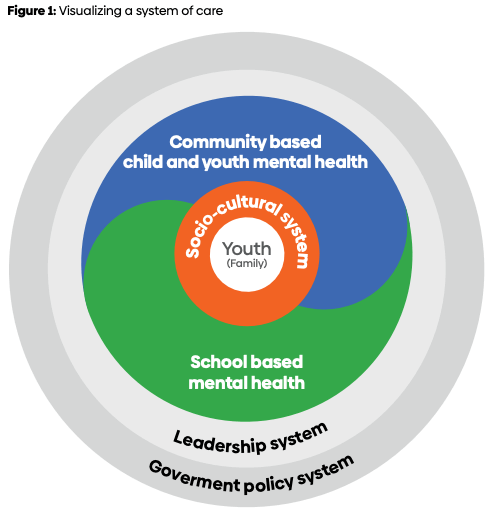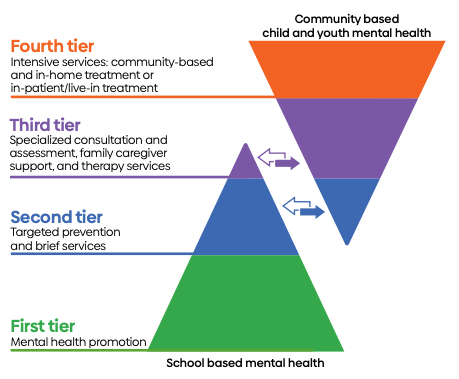Ontario’s system of care for child and youth mental health: unpacking the roles
Schools and the community-based mental health sector are working together to ensure children, youth, and families have access to the right mental health supports at the right time for their needs.
Ontario’s system for supporting child and youth mental health includes schools, the community-based mental health and addictions sector, hospitals, youth wellness hubs, cultural and faith organizations, public health, and many others. To effectively meet the mental health needs of every young person in Ontario, these service settings can collaboratively provide a range of interventions and treatment options in different contexts, at different intensity levels. This range of offerings provides choice for young people and their families, but it can also be complex to navigate. Together, we are working hard to help make this easier.
The vision for a coordinated system of care in Ontario is outlined in Right time, right care, a report developed by partners from the school and community mental health systems, specifically the Lead Agency Consortium, Knowledge Institute for Child and Youth Mental Health, Children’s Mental Health Ontario, and School Mental Health Ontario. The content of this post was sourced from the report to provide general information about the vision for a system of care in Ontario.
Visualizing a system of care
A coordinated system of care should ensure a good match between the expressed needs of young people and available services in order to improve the experience of youth and families with respect to help-seeking, service access, and cultural/community responsivity. As this visual suggests, a continuum of services is wrapped around the young person and their family, in the school and community, building on existing identity affirming sociocultural strengths and supports.

A circle graphic with Youth (Family) in the centre.
An orange ring around the centre says socio-cultural system.
The next ring is thicker and divided into two equal sections surrounding the circle’s centre parts. The blue section is labelled community-based child and youth mental health. The green section is labelled school-based mental.
A narrower light grey ring surrounds this large ring labelled Leadership system, followed by another grey ring labelled government policy system.
The role of schools
Schools have a critical role in Ontario’s mental health care system for children and youth. This role is focused on mental health literacy and wellness promotion, early identification, prevention, and early intervention. The goal is to help every student to flourish while noticing and intervening early for those who show signs of an emerging or escalating mental health problem. Early intervention can reduce the need for more intensive mental health supports. School mental health professionals (e.g., psychology and social work staff) use a range of brief evidence-informed protocols to help students who are experiencing difficulties with their mental health. See the blog on Brief Digital Interventions for example.
The role of community-based child and youth mental health and addictions agencies
In community-based settings, service providers offer a continuum of care across seven core services for children and young people experiencing mild, moderate to serious mental health issues. Mental health professionals use evidence informed assessment tools and treatment modalities to match client needs and strengths to the services that can best meet these needs. The focus is the child and young person within the family context. Community mental health organizations work closely with health, education and other sectors to ensure that children, young people and families can move seamlessly from lower to higher intensity supports as needs require.
Working together as a multi-tiered system of support
Both the education and the community mental health sectors use a multi-tiered system of support model to depict and understand the continuum of supports available. The tiered models are overlayed as part of a coordinated support system, and young people can move between them.

The graphic includes an upright triangle and an inverted triangle. Each triangle is divided into three sections.
The upright triangle on the left is labelled school-based mental health and includes:
- A large bottom section in green labeled first tier mental health promotion
- A slightly smaller blue section in the middle labelled second tier targeted prevention and brief services
- A small purple section at the point labelled tier three specialized consultation and assessment, family caregiver support, and therapy services
The inverted triangle is labelled community-based mental health services and is to the right of the upright triangle.
- Its point is a blue section and aligns with the middle blue area of the first triangle, which is labelled second tier. There are arrows between the sections of both triangles to depict how someone can move between the services available at tier two in school or the community.
- The section above the point is purple and larger. It aligns with the small tier 3 purple section on the first triangle. Again, arrows between the sections depict movement or collaboration between school and community services.
- Lastly, a large orange section is labelled fourth tier Intensive services: community-based and in-home treatment or in-patient/live-in treatment.
Roles within Ontario’s system of child and youth mental health and addictions supports
For many young people, the mental health literacy support and mental health promotion activities that happen as part of tier one through school-based mental health will be enough to help them flourish. Some students will need more support and then move between the tiers of the overall support system. The following role descriptions can help to explain how individuals interact with the system and support its success.
Child or young person
- Communicates or demonstrates a need for help and/or shows openness to exploring the possibility of receiving services/treatment.
- Engages in service and contributes to their self-care in ways that feel safe.
- Provides age-appropriate background information, ideas and input to develop their service plan.
- Provides feedback to improve services and enhance the service experience over time.
Family, parent or caregiver
- Shows awareness of mental health concerns.
- Offers support to the child or young person.
- Connects with the school and/or community-based services to obtain required supports.
- Provides background information, ideas and input to the development of the service plan.
- Engages in service when and to the extent that it is appropriate.
- Provides feedback to improve services and enhance the service experience over time.
School staff (administrator, teacher, learning resource teacher, child and youth worker, early childhood educator, Indigenous grad coach, educational assistant, chaplain, other)
- Provides a mentally healthy school and classroom environment.
- Notices when students are struggling.
- Communicates and collaborates with child, young person and family regarding concerns.
- Brings their concerns about the student to the established internal pathway for referral.
- Reviews recommendations re: accommodations for the student.
- Accommodates the learning plan and school environment to support student’s needs.
- Provides non-judgmental support to student and integration when needed.
- Observes, documents and describes specific student behaviour to support referral, assessment, or treatment process.
- Maintains ongoing communication to support the treatment plan.
- Provides system feedback to improve services over time and to enhance the service experience.
School mental health professional
- Supports school staff with consultation related to accommodating the school environment and providing tailored scaffolded supports to help students with mental health problems.
- Provides professional learning and coaching for school staff.
- Provides school-based mental health or learning assessment and/or prevention and early intervention services (individual or group), using evidence-informed protocols and identity-affirming approaches.
- In collaboration with the child/young person/family and school team, provides triage, referral and bridging support to, from and through community services with consent from the child/young person.
- Provides crisis response, in collaboration with family, community and health system partners, as situations require.
- Provides system feedback to improve services over time and to enhance the service experience.
Community-based child and youth mental health and addictions professionals
- Provides intake, assessment, crisis response if needed, and coordinated treatment with the child/young person/family aged 0 to 18 (individual or group).
- Treatment is provided based on need; from single solution treatment sessions; to longer term therapy; to in-home or day treatment and live-in treatment.
- Engages child/young person/family in service planning and goal-setting.
- Works in inter-professional teams of psychiatrists, psychologists, nurses, social workers, psychotherapists, child and youth workers, occupational and physical therapists.
- Makes additional referrals where appropriate.
- Shares outcomes/recommendations with family and school team to facilitate support planning (with appropriate/required consents in place).
Creating change within and between sectors isn’t easy—while everyone involved in the system needs to understand the vision and their role, it’s not enough for change to happen. The Right time, right care implementation working group is developing tools and resources to support local planning and operationalization of the system of care vision while also continuing to work alongside Ministry of Health and Ministry of Education partners to build on the good work represented in the original report.
